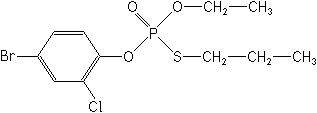Pesticides >> Insecticides >> Profenofos
Profenofos 40%EC
Insecticide, acaricide
organophosphorus

NOMENCLATURE
Common name profenofos (BSI, E-ISO, (m) F-ISO, ANSI, ESA)
IUPAC name O-4-bromo-2-chlorophenyl O-ethyl S-propyl phosphorothioate
Chemical Abstracts name O-(4-bromo-2-chlorophenyl) O-ethyl S-propyl
phosphorothioate
CAS RN [41198-08-7] EEC no. 255-255-2 Development codes CGA 15 324
(Ciba-Geigy) Official codes OMS 2004
APPLICATIONS
Biochemistry Cholinesterase inhibitor. The separate optical isomers,
due to the chiral phosphorus atom, show different types of insecticidal
activity and ability to inhibit acetylcholinesterase (H. Leader
& J. E. Casida, J. Agric. Food Chem., 1982, 30, 546). Mode of
action Non-systemic insecticide and acaricide with contact and stomach
action. Exhibits a translaminar effect. Has ovicidal properties.
Uses Control of insects (particularly Lepidoptera) and mites on
cotton, maize, sugar beet, soya beans, potatoes, vegetables, tobacco,
and other crops, at 250-1000 g/ha. Phytotoxicity Slight reddening
of cotton may occur. Formulation types EC; UL. Selected tradenames:
'Curacron' (Syngenta); 'Profex' (Nagarjuna Agrichem); 'Sanofos'
(Sanonda)
OTHER TRADENAMES
'Selecron' (Syngenta); 'Carina' (Pesticides India); 'Profex super'
(Nagarjuna Agrichem) mixtures: 'Polytrin C' (+ cypermethrin) (Syngenta);
'Sirene-BW' (+ grandlure) (IPM Technologies)
ANALYSIS
Product analysis by glc. Residues determined by glc with TID. Details
available from Syngenta.
Profenofos MAMMALIAN TOXICOLOGY
Reviews FAO/WHO 59, 61 (see part 2 of the Bibliography). Oral Acute
oral LD50 for rats 358, rabbits 700 mg/kg. Skin and eye Acute percutaneous
LD50 for rats c. 3300, rabbits 472 mg/kg. Non-irritant to the skin
and eyes of rabbits. Inhalation LC50 (4 h) for rats c. 3 mg/l air.
NOEL (using EC formulation 380 g a.i./l) for rats (2 y) 0.3 mg a.i./kg
diet; for lifetime study 1.0 mg a.i./kg diet; for mice 0.08 mg/kg
diet. ADI (JMPR) 0.01 mg/kg b.w. [1990]. Toxicity class WHO (a.i.)
II; EPA (formulation) II EC hazard Xn; R20/21/22
Profenofos ECOTOXICOLOGY
Birds LC50 (8 d) for bobwhite quail 70-200, Japanese quail >1000,
mallard ducks 150-612 ppm. Fish LC50 (96 h) for rainbow trout 0.08,
crucian carp 0.09, bluegill sunfish 0.3 mg/l. Algae Toxic to algae.
Other aquatic spp. Highly toxic to crustaceans. Bees Toxic to bees.
Worms Practically non-toxic to earthworms.
ENVIRONMENTAL FATE
EHC 63 (WHO, 1986; a general review of organophosphorus insecticides).
Animals Rats rapidly excrete 14C-profenofos after oral administration.
The predominant metabolic pathway involves stepwise dealkylation
and hydrolysis, followed by conjugation. Plants In cotton, Brussels
sprouts and lettuce, the compound is rapidly taken up and metabolised.
The overall metabolic pattern indicates degradation to polar metabolites.
Soil/Environment Mean half-life in soil (lab. and field) is c. 1
week.